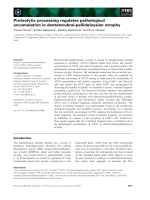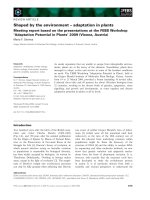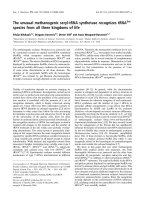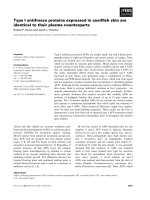báo cáo khoa học: "Fulminant Leptospirosis (Weil’s disease) in an urban setting as an overlooked cause of multiorgan failure: a case report" pptx
Bạn đang xem bản rút gọn của tài liệu. Xem và tải ngay bản đầy đủ của tài liệu tại đây (236.39 KB, 4 trang )
CAS E RE P O R T Open Access
Fulminant Leptospirosis (Weil’s disease) in an
urban setting as an overlooked cause of
multiorgan failure: a case report
Elias Maroun
*
, Anurag Kushawaha, Elie El-Charabaty, Neville Mobarakai, Suzanne El-Sayegh
Abstract
Introduction: Leptospirosis has recently come to international attention as a globally important re-emerging
infectious disease. Our case is unusual given the season, location and setting in which leptospirosis occurred.
According to the New York City Board of Health, there were only two other cases of leptospirosis in New York City
in the year that our patient was diagnosed.
Case presentation: A 49-year-old healthy Chinese man presented to our hospital with sepsis and multiorgan
failure. The patient did not respond to antibiotics and his multiorgan failure worsened. His workup did not show
any significant findings except for a positive nasopharyngeal swab result for influenza A. Later the patient
developed hemoptysis with evidence of bilateral infiltrates on radiography. His status mildly improved after he was
started on steroids. Eventually, a microagglutination test confirmed the presence of antibodies against Leptospira
icterohaemorrhagiae. The patient subsequently recovered after a course of intravenous antibiotics.
Conclusion: The case of fulminant leptospirosis presented here should serve to alert health care providers and the
general public to the clinical importance of this severe, sometimes fatal, disease. Leptospirosis should be
considered early in the diagnosis of any patient with acute, non-specific febrile illness with multiorgan system
involvement or high fever in a returning traveler. In addition, not only should it be considered in tropical and rural
areas between late summer to early fall, but also in any location or time if the risk factors are prese nt.
Introduction
Leptospirosis is a zoonosis of worldwide distribution
caused by infection with Leptospira interrogans,apatho-
genic spirochete. The most important reservoirs are
rodents, predominantly rats. Urinary shedding of organ-
isms from infected animals is the most significant source
of Leptospira spp. The majority of patients manifest a
mild, anicteric febrile illness, but a minority of patients
develop a severe form with multiorgan involvement,
called Weil’s disease. Weil’ s disease is characterized by
multisystem dysfunction and can present with high fever,
significant jaundice, renal failure, hepatic necrosis, pul-
monary involvement, cardiovascular coll apse, neurologic
changes and hemorrhagic diathesis.
Case presentation
A 49 year-old man of Chinese descent with no medical
history presented in mid-January to our hospital for a
history of fever (102.5°F), myalgias, and severe bilateral
calf pain that began six days prior.
He had a 30 pack-year history of cigarette smoking,
drank four to six beers almost every day for two years
and smoked marijuana occasionally. He denied recent
travel, owned two healthy pets and worked as a con-
struction worker. The patient denied any recent travel
outside the USA. He denied recent antibiotic exposure
or sick contacts.
Vital signs in the emergency department were notable
for a temperature of 101°F, pulse of 120 beats/min and
blood pressure of 156/63 mm Hg. The patient was alert
and oriented. The ocular examination was notable for
scleral icterus. The skin appeared jaundiced, the lungs
were clear to auscultation, the abdomen was soft,
* Correspondence:
Staten Island University Hospital, 475 Seaview Avenue, Staten Island,
NY 10305 USA
Maroun et al. Journal of Medical Case Reports 2011, 5:7
/>JOURNAL OF MEDICAL
CASE REPORTS
© 2011 Maroun et al; licensee BioMed Central Ltd. This is an Open Access article distributed under the terms of the Creative Co mmons
Attribution Lic ense (h ttp: //creativecommons.org/licenses/by/2.0), which permits unrestricted use, dis tribution, and reproduction in
any medium, provided the orig inal work is properly cited.
bilateral lower extremity tenderness was noted and dor-
sal pedal pulses were present bilaterally.
Initial laboratory study results were notable for a crea-
tinine of 2.3 mg/dL, platelets of 58,000 cells/mm
3
,
hemoglobin of 12.8 G/dL, white blood cell count of
8.9 × 10
3
cells/mm
3
with lymphopenia of 2.4%, total
bilirubin of 4.3 mg/dL, direct bilirubin of 2.6 mg/dL,
alkaline phosphatase (ALP) of 143 U/L, aspartate amino-
transferase (AST) of 201 U/L, alanine aminotransferase
(ALT) of 246 U/L, and creatine kinase of 1219 U/L. The
urine analysis s howed moderate hematuria but no pro-
teinuria. Results o f lower extremity Doppler ultrasono-
graphy and chest radiography were negative, and
electrocardiography showed normal sinus rhy thm at
76 beats/min.
The patient was admitted to the intensive care unit for
sepsis and multiorgan dysfunction. Intravenous (IV) cef-
triaxone and vancomycin were initiated with aggressive
fluid resuscitation.
The following day, the patient’s acute renal failure,
hyperbilirubinemia, anemia and thrombocytopenia wor-
sened. Serologic test results for acute hepatitis A, B and
C infections were negative. A peripheral smear showed
no schistocytes. Levels of C3, C4, antinuclear antibodies,
anti-dsDNA, antineutrophil cytoplasmic antibodies, and
anti-glomerular basement membrane antibodies were
within normal limits. Renal ultrasonography results were
normal . Computed tomography of t he abdome n showed
pancolitis, cholelithiasis and nephromegaly.
On the third day, the patien t had wors ening oxygena-
tion with slight hemoptysis and developed new inferior
bilateral infiltrates. Physical examination revealed the
development of fine crackles at the bases of his lungs.
Arterial blood gas on 2 L of oxygen revealed a pH of
7.45, PCO
2
(partial pressure of carbon dioxide) of 28,
PO
2
(partial pressure of oxygen) of 55, oxygen satura-
tion of 90% and bicarbonate of 19.5. The antibiotic regi-
men was broadened to IV cefepime, and vancomycin
was continued. The right u pper quadrant sonogram
showed thickening of the gallbladder wall. Urine legio-
nella antigen and serum HIV antibody results were
negative. Initial blood cultures and sputum culture
results were negative. The patient’ s acute renal failure,
hyperbilirubinemia, anemia and thrombocytopenia con-
tinued to deteriorate. The patient was started on 125
mg of methylprednisone every six hours for five days
and desmopressin for suspicion of alveolar hemorrhage
in the presence of renal failure.
On the four th hospital day, a nasopharyngeal swab for
influenza A was conducted, and results were positive.
All antibiotics were stopped, and the patient received
one dose of oseltamivir. The patient’s clinical status and
renal failure started to improve, but the cholestatic pic-
ture was worsening, with a total bilirubin of 64.7 mg/dL,
direct bilirubin of 44.8 mg/dL, AST of 87 U/L and ALT
of 121 U/L.
On the fift h day, the patient developed a maculopapu-
lar, nonpruritic rash on the face, torso, abdomen and
upper extremities involving the palms. Biopsy was done
and showed lichenoid dermatitis (drug react ion) . Serum
leptospira antibodies were sent to the NYC Board of
Health for specialized testing. While the patient was tak-
ing corticosteroids, the hyperbilirubinemia, thrombocy-
topenia, hemoptysis and renal failure resolved over the
next few days. The final laboratory study results were
notable for a creatinine of 0.8 mg/dL, total bilirubin of
1.8 mg/dL and platelets of 165 cells/mm
3
.Therewasa
near complete resolution of the chest radiography find-
ings. Furthermore, the rash and the patient’ s calf pain
gradually improved, and the patient was subsequently
discharged.
Two weeks later, the NYC Board of Health reported
the antibodies for leptospira as positive. A microaggluti-
nation test (MAT) confirmed the serovar Leptospira
icterohaemorrhagiae, with the titers 1:6400. The patient
was recalled for insertion of an indwelling catheter for a
14-day course of IV ceftria xone after which he improved.
Retrospectively, after having been asked about any epide-
miologic factors that placed him at risk for contracting
leptospirosis, the patient admitted to having be en in con-
tact with rat urine with his bare hands at a construction
site in NYC.
Discussion
Leptospirosis is a zoonosis of worldwid e distribution
caused by infection with L. interrogans, a pathogenic spir-
ochete. The organism infects a variety of animals, espe-
cially rodents and animals associated with farming.
Humans represent only incidental infection usually
through work-related contact through skin or mucous
membranes, typical ly after exposure to water or soil con-
taminated with urine from an infected animal or via
drinking of or bathing in contaminated water. The main
occupational groups at risk are farm workers, field agri-
cultural workers, plumbers, sewer workers, sanitation
workers and military troops.
Leptospira are spiral-shaped, thin, motile organisms
with flagella. The most common serovars are icteroha e-
morrhagi ae, which are usually found in rats (Rattus nor-
vegicus). Urinary shedding of organisms from infected
animals is the most significant source of Leptospira spp.
because the spirochetes can persist for long periods of
time in the renal tubules.
The natural course of leptospirosis comprises of two
distinct clinical phases: septicemic and immune.
Humans typically become ill seven to 12 days after
exposure to leptospires. The first stage is called the sep-
ticemic phase (leptospiremic phase) because the bacteria
Maroun et al. Journal of Medical Case Reports 2011, 5:7
/>Page 2 of 4
may be isolated from blood cultures and cerebrospinal
fluid (CSF). This phase is characterized by a nonspecific
flulike illness with sudden onset of high fever, headache,
myalgias (classically involving the paraspinal, calf and
abdominal muscles) [1] and conjunctival suffusion. Con-
junctival suffusion (reddening of the eye surface) is a
characteristic physical finding in leptospirosis, and its
presence in a patient with a nonspecific febrile illness
should raise suspicion for diagnosis.
The second stage is called the immune phase (leptos-
piruric phase) when circulating antibodies can be
detected and the bacteria c an be isolated from the urine.
This stage occurs as a result of the body’ s immunologic
response by producing immunoglobulin M antibodies
and can last longer than one month. During this stage,
specific organ damage can be observed. Aseptic meningi-
tis is one of the most important clinical syndromes that
can occur in 80% of patients during the immune phase.
Renal symptoms, such as uremia, azotemia, pyuria and
hematuria, may occur. Pulmonary manifestations,
although usually benign, can be potentially life threaten-
ing and range from chest pain, cough and dyspnea to pul-
monary hemorrhage or acut e respiratory distress
syndrome. An increase in liver enzymes (up to five times
normal) with a disproportionately high total bilirubin has
been described as a prognostic indicator in leptospirosis
[2]. Varying degrees of jaundice, pancreatitis, hepatome-
galy and myocarditis can also occur.
Weil’s disease is the most severe form of leptospirosis.
Patients can present with high fever (>40°C), significant
jaundice, renal failure, hepatic necrosis, pulmonary
involvement, cardiovascular collapse, neurologic changes
and hemorrhagic diathesis, with a variable clinical
course. Weil’s disease can occur at the end of the first
stage and peaks during the second stage but can occur
at any time during acute leptospirosis as a single, pro-
gressive illness.
Acute renal failure is one of the most common com-
plications of severe leptospirosis. Renal leptospirosis is
usually described as a combination of acute tubular
damage and interstitial nephritis.
A particularly serious type of lung involvement called
severe pulmonary hemorrhagic syndrome is considered
to be a major cause of death in patients with Weil’s dis-
ease in developing countries, with profuse lung hemor-
rhage dominating the clinical picture [3].
Hepatic dysfunction is usually mild and reversible.
Liver dysfunction in severe leptospirosis can be seen as
conjugated serum bilirubin levels may increase to above
80 mg/dL, accomp anied by modest elevations in transa-
minases, which rarely exceed 200 U/L [4].
Variable degrees of thrombocytopenia have been
reported with leptospirosis. The p athogenesis of
thrombocytopenia and hemorrhagic diathesis in leptos-
pirosis is not well understood.
Overall, Weil’s syndrome has a mortality rate of 5% to
10%. Important causes of death include renal failure,
cardiopulmonary failure and widespread hemorrhage [5].
The diagnosis of leptospirosis requires a high degree
of clinical suspicion because the disease’ snumerous
manifestations can mimic other tropical infections or
other nonspecific febrile illnesses, as well as noninfec-
tious disea ses such as small vessel vasculitides, sys temic
lupus erythematosus or even malignancies. The initial
diagnosis of leptospiro sis remains a clinical one, a pre-
sumed analysis in the appropriate epidemiologic and
clinical context. Routine laboratory testing is nondiag-
nostic but may show elevated erythrocyte sedimentation
rate, peripheral leukocytosis, variab le degrees of cytope-
nias, mildly increased aminotransferases and increased
serum bilirubin and ALP.
Isolation of the organism by culture of clinical speci-
mens (blood, CSF, urine) during the first seven to 10
days of the illness is considered the gold standard of
diagnosis. However, this method is difficult, requires
longer than 16 weeks because initial growth may be
slow and has a low sensitivity and specificity. The
majority of leptospirosis cases are diagnosed by serologic
testing of which MAT is most common
The vast majority of infections with leptospira are self-
limiting, and it remains controversial if antimicrobials
produce benefit in cases of mild leptospirosis without
end-organ damage. The current choices of treatment for
mild leptospirosis include oral doxycycline and amoxicil-
lin. Parenteral high-dose penicillin G has long been
considered the treatment of choice of fulminant leptos-
pirosis. Recent trials have demonstrated that the bro ad-
spectrum third generation cephalosporins cefotaxime
and ceftriaxone are also acceptable agents for patients
with severe leptospirosis [6,7].
The use of steroids in patients with leptospirosis has
not been well established. In the current case, the
improvement of the patient’s renal dysfunction, throm-
bocytopenia and hemoptysis may be attributed to the
introduction of steroids. Several case reports have
described the beneficial effects of glucocorticoids in
severe leptospirosis with pulmonary hemorrhage [8],
thrombocytopenia [9] and renal failure [10,11].
Public health measures to preve nt and reduce leptos-
pirosis include identification of contaminated water
sources, rodent control, prohibition of swimming in
waters where risk of infection is high and informing per-
sons of the risk involved in recreational water activities.
In the case of our patient, the diagnosis of leptospiro-
sis was not initially considered because potential risk
factors were not identified at the outset. The majority of
Maroun et al. Journal of Medical Case Reports 2011, 5:7
/>Page 3 of 4
cases of leptospirosis occur in the tropics, with infre-
quent incidences in temperate regions. Adding another
atypical facet to the patient’s presentation, in the United
States, the majority of cases occur in the Southern and
Pacific coastal states, with Hawaii having the most
reported cases. Also, our patient presented in the win-
tert ime. Most cases of leptospirosis occurring in tempe-
rate areas occur in the late summer to early fall [1].
According to the NYC Board of Health, between 2008
and summer 2009, there were only three cases of leptos-
pirosis in NYC (including our patient).
Conclusion
In conclusion, leptospirosis has recently come to inter-
national attention as a globally important reemerging
infectious disease in not only developing countries but
in industrialized nations as well. In July 2007, a sus-
pected leptospirosis outbreak was reco gnized among
strawberry harvesters in Germany and was found to be
the largest leptospi rosis epidemic to occur in Germany
since the 1960s [12]. Leptospirosis has also been docu-
mented as a militarily relevant infectious disease during
times of troop deployment [13]. The implications of this
case are noteworthy for several reasons. The case of ful-
minant leptospirosis presented here should serve to alert
health care providers and the general public to the clini-
cal importance of this severe, sometimes fatal, disease.
Leptospirosis remains a great burden of infection in
third world countries, and mortality remains significant
related to lack of a rapid, reliable diagnostic test and the
need for a high degree of clinical suspicion. An accurate
and quick diagnostic test is warranted in the interest of
the individual patient, as well as public health. Recogni-
tion of fulminant leptospirosis is especially important
because antimicrobi al agents can reduce its severity and
duration as well as lead to a favorable outcome of this
potentially lethal condition.
Consent
Written informed consent was obtained from the patient
for publication of this case report and accompanying
images. A copy of the written consent is available for
review by the journal’s Editor-in-Chief.
Abbreviations
ALP: alkaline phosphatase; ALT: alanine aminotransferase; AST: aspartate
aminotransferase; CSF: cerebrospinal fluid; IV: intravenous; MAT: microscopic
agglutination test; PCO
2
: partial pressure of carbon dioxide; PO
2
: partial
pressure of oxygen.
Authors’ contributions
EM was the major contributor to the case presentation, conducted literature
review and did manuscript revisions. AK was the major contributor to the
discussion section, conducted literature review and did manuscript revisions.
EE was involved in direct patient care as the hospitalist. NM was involved in
direct patient care as the infectious disease specialist. SE was involved in
direct patient care as the renal specialist. All authors have read and
approved the final manuscript.
Competing interests
The authors declare that they have no competing interests.
Received: 7 December 2009 Accepted: 14 January 2011
Published: 14 January 2011
References
1. Levett PN, Haake DA: Leptospira species (leptospirosis). In: Principles and
Practice of Infectious Diseases.Edited by: Mandell GL, Bennett JE, Dolin R.
Philadelphia: Churchill Livingstone Elsevier; , 7 2010:3059-3065.
2. Chang ML, Yang CW, Chen JC, Ho YP, Pan MJ, Lin CH, Lin DY:
Disproportional exaggerated aspartate transaminase is a useful
prognostic parameter in late leptospirosis. World J Gastroenterol 2005,
11(35):5553-5556.
3. Vijayachari P, Sehgal SC, Goris MG, Terpstra WJ, Hartskeerl RA: Leptospira
interrogans serovar Valbuzzi: a cause of severe pulmonary
haemorrhages in the Andaman Islands. J Med Microbiol 2003, 52(Pt
10):913-918.
4. Edwards GA, Domm BM: Leptospirosis. Med Times 1966, 94(9):1086-1095, II.
5. Terpstra W: Human Leptospirosis: Guidance for Diagnosis, Surveillance, and
Control Geneva: World Health Organization; 2003.
6. Raptis L, Pappas G, Akritidis N: Use of ceftriaxone in patients with severe
leptospirosis. Int J Antimicrob Agents 2006, 28(3):259-261.
7. Suputtamongkol Y, Niwattayakul K, Suttinont C, Losuwanaluk K,
Limpaiboon R, Chierakul W, Wuthiekanun V, Triengrim S, Chenchittikul M,
White NJ: An open, randomized, controlled trial of penicillin, doxycycline,
and cefotaxime for patients with severe leptospirosis. Clin Infect Dis 2004,
39(10):1417-1424.
8. Shenoy VV, Nagar VS, Chowdhury AA, Bhalgat PS, Juvale NI: Pulmonary
leptospirosis: an excellent response to bolus methylprednisolone.
Postgrad Med J 2006, 82(971):602-606.
9. Wagenaar JF, Goris MG, Partiningrum DL, Isbandrio B, Hartskeerl RA,
Brandjes DP, Meijers JC, Gasem MH, van Gorp EC: Coagulation disorders in
patients with severe leptospirosis are associated with severe bleeding
and mortality. Trop Med Int Health 2010, 15(2):152-159.
10. Meaudre E, Asencio Y, Montcriol A, Martinaud C, Graffin B, Palmier B,
Goutorbe P: [Immunomodulation in severe leptospirosis with multiple
organ failure: plasma exchange, intravenous immunoglobulin or
corticosteroids?]. Ann Fr Anesth Reanim 2008, 27(2):172-176.
11. Dursun B, Bostan F, Artac M, Varan HI, Suleymanlar G: Severe pulmonary
haemorrhage accompanying hepatorenal failure in fulminant
leptospirosis. Int J Clin Pract 2007, 61(1):164-167.
12. Desai S, van Treeck U, Lierz M, Espelage W, Zota L, Sarbu A, Czerwinski M,
Sadkowska-Todys M, Avdicova M, Reetz J, et al: Resurgence of field fever
in a temperate country: an epidemic of leptospirosis among seasonal
strawberry harvesters in Germany in 2007. Clin Infect Dis 2009,
48(6):691-697.
13. Murray CK, Horvath LL: An approach to prevention of infectious diseases
during military deployments. Clin Infect Dis 2007, 44(3):424-430.
doi:10.1186/1752-1947-5-7
Cite this article as: Maroun et al.: Fulminant Leptospirosis (Weil’s
disease) in an urban setting as an overlooked cause of multiorgan
failure: a case report. Journal of Medical Case Reports 2011 5:7.
Maroun et al. Journal of Medical Case Reports 2011, 5:7
/>Page 4 of 4









